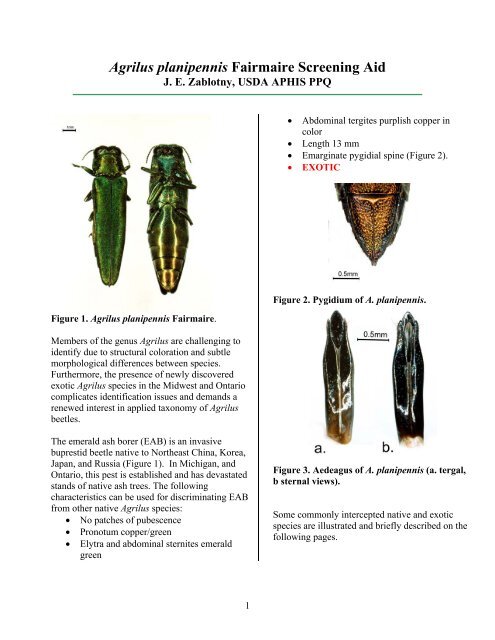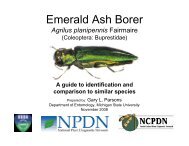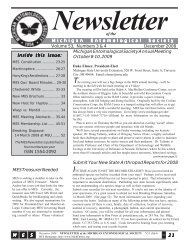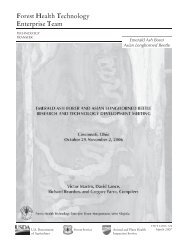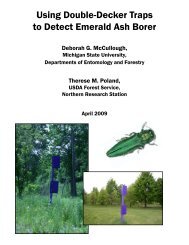Agrilus planipennis Screening Aid - Emerald Ash Borer
Agrilus planipennis Screening Aid - Emerald Ash Borer
Agrilus planipennis Screening Aid - Emerald Ash Borer
Create successful ePaper yourself
Turn your PDF publications into a flip-book with our unique Google optimized e-Paper software.
<strong>Agrilus</strong> <strong>planipennis</strong> Fairmaire <strong>Screening</strong> <strong>Aid</strong>J. E. Zablotny, USDA APHIS PPQ• Abdominal tergites purplish copper incolor• Length 13 mm• Emarginate pygidial spine (Figure 2).• EXOTICFigure 1. <strong>Agrilus</strong> <strong>planipennis</strong> Fairmaire.Members of the genus <strong>Agrilus</strong> are challenging toidentify due to structural coloration and subtlemorphological differences between species.Furthermore, the presence of newly discoveredexotic <strong>Agrilus</strong> species in the Midwest and Ontariocomplicates identification issues and demands arenewed interest in applied taxonomy of <strong>Agrilus</strong>beetles.Figure 2. Pygidium of A. <strong>planipennis</strong>.The emerald ash borer (EAB) is an invasivebuprestid beetle native to Northeast China, Korea,Japan, and Russia (Figure 1). In Michigan, andOntario, this pest is established and has devastatedstands of native ash trees. The followingcharacteristics can be used for discriminating EABfrom other native <strong>Agrilus</strong> species:• No patches of pubescence• Pronotum copper/green• Elytra and abdominal sternites emeraldgreenFigure 3. Aedeagus of A. <strong>planipennis</strong> (a. tergal,b sternal views).Some commonly intercepted native and exoticspecies are illustrated and briefly described on thefollowing pages.1
<strong>Agrilus</strong> bilineatus (Weber):<strong>Agrilus</strong> anxius (Weber)Figure 4. <strong>Agrilus</strong> bilineatus (Weber)• Pubescent line on pronotum extendingdown each elytron.• Bronze-black to dark blue.• Length 11 mm• Host Quercus spp.<strong>Agrilus</strong> cyanescens RatzeburgFigure 6. <strong>Agrilus</strong> anxius (Weber)• No patches of pubescence.• Bronze-black• Length 12-13 mm• Host: Betula spp.<strong>Agrilus</strong> vittaticollis(Randall)Figure 5 <strong>Agrilus</strong> cyanescens RatzeburgFigure 7. <strong>Agrilus</strong> vittaticollis (Randall)• Pubescent line on pronotum.• Pronotum copper colored with darkelytra, darker below with violethighlights.• Length 10-12mm• Hosts: Crataegus, Malus,• Amelenchier spp.• No patches of pubescence.• Metallic blue in color, darker below.• Length 8 mm• Host: Lonicera spp.• EXOTIC2
<strong>Agrilus</strong> obsoletoguttatussmall in size (>4.0 mm) and features a distinctsubbassal and subapical spots of scale-likepubescence on the elytra (Figure 10).GoryFigure 8. <strong>Agrilus</strong> obsoletoguttatus Gory• Pubescent spots on elytra.• Copper color with violet elytral apices,darker below.• Length 9-10 mm• Hosts: Hardwood spp.<strong>Agrilus</strong> masculinusFigure 10. <strong>Agrilus</strong> subcinctus GoryAll of these <strong>Agrilus</strong> are often found on sticky andin funnel trap samples. With close to 50 <strong>Agrilus</strong>species known from the Midwest, I expect otherspecies to be added to this preliminary guide inthe near future.HornFigure 9. <strong>Agrilus</strong> masculinus Horn• No distinct patches of pubescence• Bronze-black, green face on males• Length 6-7 mm• Hindleg tarsi longer than tibia• Host: Acer negundoIn addition to <strong>Agrilus</strong> <strong>planipennis</strong>, A. subcinctusGory is the only other <strong>Agrilus</strong> species known tooccur on Fraxinus in the Midwest. A. subcinctusdiffers behaviorally from A. <strong>planipennis</strong> in that itis a twig borer and prefers smaller banches foroviposition. In the field, A. subcinctus can besweep-netted from ash leaves. A. subcinctus is3


